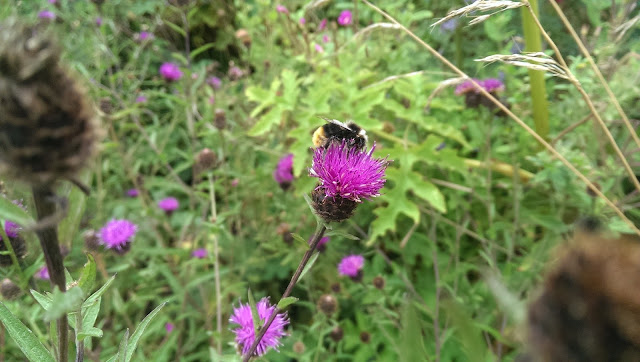The JJ Garden
Friday, 6 November 2015
Wednesday, 14 October 2015
Honey bees smell like bananas
Research on
honey bees at the University of Sussesx is primarily carried out in LASI, a lab specialising in honey bees
and other social insects. I won’t pretend to know much at all about honey bees,
their ecology is very different from the wild species I study, but one of the
many behavioural elements they study is the pheromones they produce. Over
lunch we were offered a bottle of the collected pheromone to smell – because naturally
this is the sort of thing we would be doing at lunch – and it has the particularly strong smell of banana-flavoured sweets.
The source
of the smell is isoamyl acetate (or banana oil), an organic compound found
naturally in banana plants - as well as in the pheromones of honey bees. There’s
a myth that the strange banana-like taste in milkshakes and sweets is based on
an old variety of banana that was supposedly wiped out by a fungus. There’s
little evidence for this. Isoamyl acetate is found in all varieties and is
extracted for food flavouring. Presumably though, it was nobody’s intention to also
make food taste like honey bee pheromones. But for future reference – that’s
what they smell like!
Monday, 5 October 2015
Thursday, 1 October 2015
MRes results - which plants attracted the most pollinators?
My study identified that, predictably, the floral resource (flowers providing pollen and nectar) was the most important determinant of pollinator presence. I will post a more detailed discussion of my findings later on (after my viva!) but here is a quick summary of my findings:
Geraniaceae, Asteraceae, Rosaceae and Lamiaceae were the most visited plant families. From memory, here are some good examples of species in these groups:
Geraniaceae, Asteraceae, Rosaceae and Lamiaceae were the most visited plant families. From memory, here are some good examples of species in these groups:
Geraniaceae - Cranesbills
Asteraceae - Fleabane
Rosaceae - Spirea
Lamiaceae - Catmint
Results of MRes - the primary determinant of pollinator presence in gardens
I looked at a variety of structural and botanical characteristics of gardens, including their size, habitat composition, location, management, use and plant diversity.
Contrary to the findings of other
studies on bumblebees and other insects*, there was no relationship between
garden size and the number or diversity of pollinators visiting a garden. In
fact, one of the small gardens I sampled contained the second highest abundance
of pollinators in the whole study, as shown below.
The most important variables were plant
abundance and diversity. Even in the smallest gardens, the right composition of
plants made them hotspots for biodiversity. Based on the diversity of plants
found in the study it is possible that gardens in Lewes are functioning not
only as self-contained habitats capable of supporting pollinators
independently, but also as ecological corridors, allowing pollinators to move
through the landscape.
(Small solitary bees <8mm, large solitary bees >8mm)
References:
Subscribe to:
Comments (Atom)






























